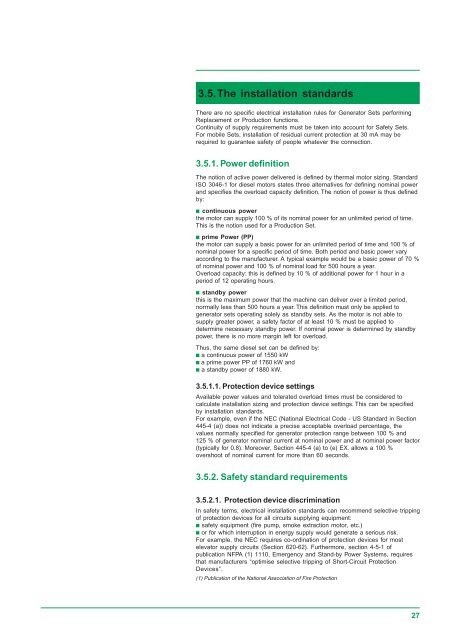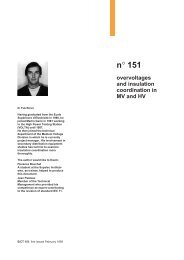LV generator protection - engineering site - Schneider Electric
LV generator protection - engineering site - Schneider Electric
LV generator protection - engineering site - Schneider Electric
Create successful ePaper yourself
Turn your PDF publications into a flip-book with our unique Google optimized e-Paper software.
3.5.The installation standardsThere are no specific electrical installation rules for Generator Sets performingReplacement or Production functions.Continuity of supply requirements must be taken into account for Safety Sets.For mobile Sets, installation of residual current <strong>protection</strong> at 30 mA may berequired to guarantee safety of people whatever the connection.3.5.1. Power definitionThe notion of active power delivered is defined by thermal motor sizing. StandardISO 3046-1 for diesel motors states three alternatives for defining nominal powerand specifies the overload capacity definition. The notion of power is thus definedby:b continuous powerthe motor can supply 100 % of its nominal power for an unlimited period of time.This is the notion used for a Production Set.b prime Power (PP)the motor can supply a basic power for an unlimited period of time and 100 % ofnominal power for a specific period of time. Both period and basic power varyaccording to the manufacturer. A typical example would be a basic power of 70 %of nominal power and 100 % of nominal load for 500 hours a year.Overload capacity: this is defined by 10 % of additional power for 1 hour in aperiod of 12 operating hours.b standby powerthis is the maximum power that the machine can deliver over a limited period,normally less than 500 hours a year. This definition must only be applied to<strong>generator</strong> sets operating solely as standby sets. As the motor is not able tosupply greater power, a safety factor of at least 10 % must be applied todetermine necessary standby power. If nominal power is determined by standbypower, there is no more margin left for overload.Thus, the same diesel set can be defined by:b a continuous power of 1550 kWb a prime power PP of 1760 kW andb a standby power of 1880 kW.3.5.1.1. Protection device settingsAvailable power values and tolerated overload times must be considered tocalculate installation sizing and <strong>protection</strong> device settings. This can be specifiedby installation standards.For example, even if the NEC (National <strong>Electric</strong>al Code - US Standard in Section445-4 (a)) does not indicate a precise acceptable overload percentage, thevalues normally specified for <strong>generator</strong> <strong>protection</strong> range between 100 % and125 % of <strong>generator</strong> nominal current at nominal power and at nominal power factor(typically for 0.8). Moreover, Section 445-4 (a) to (e) EX. allows a 100 %overshoot of nominal current for more than 60 seconds.3.5.2. Safety standard requirements3.5.2.1. Protection device discriminationIn safety terms, electrical installation standards can recommend selective trippingof <strong>protection</strong> devices for all circuits supplying equipment:b safety equipment (fire pump, smoke extraction motor, etc.)b or for which interruption in energy supply would generate a serious risk.For example, the NEC requires co-ordination of <strong>protection</strong> devices for mostelevator supply circuits (Section 620-62). Furthermore, section 4-5-1 ofpublication NFPA (1) 1110, Emergency and Stand-by Power Systems, requiresthat manufacturers “optimise selective tripping of Short-Circuit ProtectionDevices”.(1) Publication of the National Association of Fire Protection27
















